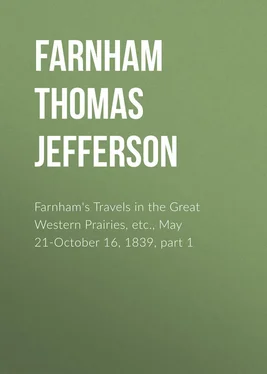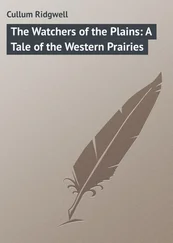Thomas Farnham - Farnham's Travels in the Great Western Prairies, etc., May 21-October 16, 1839, part 1
Здесь есть возможность читать онлайн «Thomas Farnham - Farnham's Travels in the Great Western Prairies, etc., May 21-October 16, 1839, part 1» — ознакомительный отрывок электронной книги совершенно бесплатно, а после прочтения отрывка купить полную версию. В некоторых случаях можно слушать аудио, скачать через торрент в формате fb2 и присутствует краткое содержание. Издательство: Иностранный паблик, Жанр: foreign_antique, foreign_prose, Путешествия и география, на английском языке. Описание произведения, (предисловие) а так же отзывы посетителей доступны на портале библиотеки ЛибКат.
- Название:Farnham's Travels in the Great Western Prairies, etc., May 21-October 16, 1839, part 1
- Автор:
- Издательство:Иностранный паблик
- Жанр:
- Год:неизвестен
- ISBN:нет данных
- Рейтинг книги:3 / 5. Голосов: 1
-
Избранное:Добавить в избранное
- Отзывы:
-
Ваша оценка:
- 60
- 1
- 2
- 3
- 4
- 5
Farnham's Travels in the Great Western Prairies, etc., May 21-October 16, 1839, part 1: краткое содержание, описание и аннотация
Предлагаем к чтению аннотацию, описание, краткое содержание или предисловие (зависит от того, что написал сам автор книги «Farnham's Travels in the Great Western Prairies, etc., May 21-October 16, 1839, part 1»). Если вы не нашли необходимую информацию о книге — напишите в комментариях, мы постараемся отыскать её.
Farnham's Travels in the Great Western Prairies, etc., May 21-October 16, 1839, part 1 — читать онлайн ознакомительный отрывок
Ниже представлен текст книги, разбитый по страницам. Система сохранения места последней прочитанной страницы, позволяет с удобством читать онлайн бесплатно книгу «Farnham's Travels in the Great Western Prairies, etc., May 21-October 16, 1839, part 1», без необходимости каждый раз заново искать на чём Вы остановились. Поставьте закладку, и сможете в любой момент перейти на страницу, на которой закончили чтение.
Интервал:
Закладка:
The Great Platte has a course by its northern fork of about one thousand five hundred miles; and by its southern fork somewhat more than that distance; from its entrance into the Missouri to the junction of these forks about four hundred miles. The north fork rises in Wind River Mountain, north of the Great Pass through Long's range of the Rocky Mountains, in latitude 42° north. 53 53 For the sources of North Platte see James's Long's Expedition , our volume xv, pp. 234-236, with accompanying note. – Ed.
The south fork rises one hundred miles west of James Peak, and within fifteen miles of the point where the Arkansas escapes from the chasms of the mountains, in latitude 39° north. 54 54 Long's expedition of 1819-20 followed the South Platte nearly to its source. See our volume xv, pp. 241-305, especially p. 292, note 141. James's Peak was the name bestowed by Long upon what is now known as Pike's Peak, because Dr. Edwin James was the first to make the ascent. Frémont restored the name of Pike in 1843. See our volume xvi, pp. 11-36, especially note 15. – Ed.
This river is not navigable for steamboats at any season of the year. In the spring floods, the batteaux of the American fur traders descend it from the forts on its forks. But even this is so hazardous that they are beginning to prefer taking down their furs in waggons by the way of the Kansas River to Westport, Missouri, thence by steamboat to St. Louis. During the summer and autumn months its waters are too shallow to float a canoe. In the winter it is bound in ice. Useless as it is for purposes of navigation, it is destined to be of great value in another respect.
The overland travel from the States to Oregon and California will find its great highway along its banks. So that in years to come, when the Federal Government shall take possession of its Territory West of the Mountains, the banks of this stream will be studded with fortified posts for the protection of countless caravans of American citizens emigrating thither to establish their abode; or of those that are willing to endure or destroy the petty tyranny of the Californian Government, for a residence in that most beautiful, productive country. Even now, loaded waggons can pass without serious interruption from the mouth of the Platte to navigable waters on the Columbia River in Oregon, and the Bay of San Francisco, in California. 55 55 For the first wagons on the Oregon Trail see De Smet's Letters , in our volume xxvii, p. 243, note 116. The Whitman party in 1836 succeeded in conveying wagons as far as Fort Boise, on Lewis River. There is no record that wagons had gone through to Walla Walla at the time of Farnham's journey. – Ed.
As it may interest my readers to peruse a description of these routes given me by different individuals who had often travelled them, I will insert it: "Land on the north side of the mouth of the Platte; follow up that stream to the Forks, four hundred miles; in this distance only one stream where a raft will be needed, and that near the Missouri; all the rest fordable. At the Forks, take the north side of the North one; fourteen days' travel to the Black Hills; thence leaving the river's bank, strike off in a North-West direction to the Sweetwater branch, at "Independence Rock," (a large rock in the plain on which the old trappers many years ago carved the word "Independence" and their own names; oval in form;) follow up the sweet-water three days; cross it and go to its head; eight or ten days travel this; then cross over westward to the head waters of a small creek running southwardly into the Platte, thence westward to Big Sandy creek two days, (this creek is a large stream coming from Wind river Mountains in the North;) thence one day to Little Sandy creek – thence westward over three or four creeks to Green River, (Indian name Sheetskadee,) strike it at the mouth of Horse creek – follow it down three days to Pilot Bute; thence strike westward one day to Ham's Fork of Green River – two days up Ham's Fork – thence West one day to Muddy Branch of Great Bear River – down it one day to Great Bear River – down this four days to Soda Springs; turn to the right up a valley a quarter of a mile below the Soda Springs; follow it up a north west direction two days to its head; there take the left hand valley leading over the dividing ridge; one day over to the waters of Snake River at Fort Hall; 56 56 This is a good brief description of the Oregon Trail as far as Fort Hall. See our volume xxi, Wyeth's Oregon , pp. 52, 53, and notes 32-34; also Townsend's Narrative , pp. 187-211, notes 36, 43, 44, 45, 51. – Ed.
thence down Snake River twenty days to the junction of the Lewis and Clark Rivers – or twenty days travel westwardly by the Mary's River – thence through a natural and easy passage in the California Mountains to the navigable waters of the San Joaquin – a noble stream emptying into the Bay of San Francisco." 57 57 This description regarding the California route shows the indefiniteness of the knowledge then current. No one is known to have passed this way save Jedediah S. Smith (1827) and Joseph Walker, sent by Captain Bonneville (1833). When Bidwell and Bartleson went out in 1841, they found no one who could give them detailed information of the route from Fort Hall to California, and they stumbled through the wilderness in great confusion. See John Bidwell, "First Emigrant Train to California," in Century Magazine , xix (new series), pp. 106-129. Mary River is that now known as the Humboldt, which rises a hundred miles west of Great Salt Lake and after a course of nearly three hundred miles west and south-west flows into Humboldt Lake or Sink. This river was originally named Ogden for Peter Skeen Ogden, a Hudson Bay factor, whose Indian wife was known as Mary. The name Humboldt was assigned by Lieutenant Frémont (1845), who does not appear to have connected it with Mary River, which he sought the preceding year. This explorer also proved (1844) that the San Joaquin and other affluents of San Francisco Bay do not "form a natural and easy passage" through the California or Sierra Nevada Mountains. – Ed.
The Platte therefore when considered in relation to our intercourse with the habitable countries on the Western Ocean assumes an unequal importance among the streams of the Great Prairie Wilderness! But for it, it would be impossible for man or beast to travel those arid plains, destitute alike, of wood, water and grass, save what of each is found along its course. Upon the head waters of its North Fork, too, is the only way or opening in the Rocky mountains at all practicable for a carriage road through them. That traversed by Lewis and Clark, is covered with perpetual snow; that near the debouchure of the South Fork of the river is over high and nearly impassable precipices; that travelled by myself farther south, is, and ever will be impassable for wheel carriages. But the Great Gap, nearly on a right line between the mouth of Missouri and Fort Hall on Clark's River – the point where the trails to California and Oregon diverge – seems designed by nature as the great gateway between the nations on the Atlantic and Pacific seas. 58 58 By the "Great Gap" Farnham intends South Pass, for which see Wyeth's Oregon in our volume xxi, p. 58, note 37. – Ed.
The Red River has a course of about one thousand five hundred miles. It derives its name from a reddish colour of its water, produced by a rich red earth or marl in its banks, far up in the Prairie Wilderness. So abundantly is this mingled with its waters during the spring freshets, that as the floods retire, they leave upon the lands they have overflowed a deposit of half an inch in thickness. Three hundred miles from its mouth commences what is called "The Raft," a covering formed by drift-wood, which conceals the whole river for an extent of about forty miles. And so deeply is this immense bridge covered with the sediment of the stream, that all kinds of vegetable common in its neighbourhood, even trees of a considerable size, are growing upon it. The annual inundations are said to be cutting a new channel near the hill. Steamboats ascend the river to the Raft, and might go fifty leagues above, if that obstruction were removed. 59 59 For this obstruction, and the clearing of it, see our volume xvii, p. 70, note 64. – Ed.
Above this latter point the river is said to be embarrassed by many rapids, shallows, falls, and sand-bars. Indeed, for seven hundred miles its broad bed is represented to be an extensive and perfect sand-bar; or rather a series of sand-bars; among which during the summer months, the water stands in ponds. As you approach the mountains, however, it becomes contracted within narrow limits over a gravelly bottom, and a swift, clear, and abundant stream. The waters of the Red River are so brackish when low, as to be unfit for common use.
Интервал:
Закладка:
Похожие книги на «Farnham's Travels in the Great Western Prairies, etc., May 21-October 16, 1839, part 1»
Представляем Вашему вниманию похожие книги на «Farnham's Travels in the Great Western Prairies, etc., May 21-October 16, 1839, part 1» списком для выбора. Мы отобрали схожую по названию и смыслу литературу в надежде предоставить читателям больше вариантов отыскать новые, интересные, ещё непрочитанные произведения.
Обсуждение, отзывы о книге «Farnham's Travels in the Great Western Prairies, etc., May 21-October 16, 1839, part 1» и просто собственные мнения читателей. Оставьте ваши комментарии, напишите, что Вы думаете о произведении, его смысле или главных героях. Укажите что конкретно понравилось, а что нет, и почему Вы так считаете.












